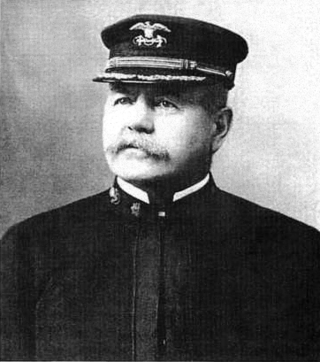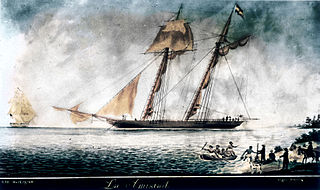
The United States Revenue Cutter Service was established by an act of Congress on 4 August 1790 as the Revenue-Marine upon the recommendation of Secretary of the Treasury Alexander Hamilton to serve as an armed customs enforcement service. As time passed, the service gradually gained missions either voluntarily or by legislation, including those of a military nature. It was generally referred to as the Revenue-Marine until 31 July 1894, when it was officially renamed the Revenue Cutter Service. The Revenue Cutter Service operated under the authority of the U.S. Department of the Treasury. On 28 January 1915, the service was merged by an act of Congress with the United States Life-Saving Service to form the United States Coast Guard.
USS Aaron V. Brown was a revenue schooner in the service of the Union Navy during the American Civil War. She was named for United States Postmaster General Aaron V. Brown, the only cutter to bear the name.

Frank Hamilton Newcomb was a United States Revenue Cutter Service commodore, best known for his actions at the Battle of Cárdenas during the Spanish–American War.

Harriet Lane was a revenue cutter of the United States Revenue Cutter Service and, on the outbreak of the American Civil War, a ship of the United States Navy and later Confederate States Navy. The craft was named after the niece of senator and later United States President, James Buchanan; during his presidency, she acted as First Lady. The cutter was christened and entered the water for the Revenue Service in 1859 out of New York City, and saw action during the Civil War at Fort Sumter, New Orleans, Galveston, Texas, and Virginia Point. The Confederates captured her in 1863, whereupon she was converted to mercantile service. Union forces recaptured her at the end of war. The U.S. Navy declared her unfit for service and sold her. New owners out of Philadelphia renamed her Elliot Ritchie. Her crew abandoned her at sea in 1881.

Washington was a revenue cutter that served in the United States Revenue-Marine and in the United States Navy. She discovered, boarded, and captured La Amistad after the slaves on board had seized control of that schooner in an 1839 mutiny.
USS Corwin was a steamer acquired by the Union Navy during the American Civil War. She was used by the Union Navy to patrol navigable waterways of the Confederacy to prevent the South from trading with other countries.
USRC Walter Forward was a schooner constructed for service with the United States Revenue-Marine. She was more commonly known as USRC Forward. Forward served with the United States Army and United States Navy in Mexican waters during the Mexican–American War and was commended for her actions during the Tabasco River landings by Commodore Matthew C. Perry, U.S. Navy. After the war, she was transferred to the United States Coast Survey for a short time as USCS Walter Forward before being returned to the Revenue-Marine for service during the 1850s and the American Civil War.

USRC Seminole was a 188 ft (57 m), 845-ton United States Revenue Cutter Service steamer constructed by the Columbian Iron Works in Baltimore, Maryland for $141,000. She was commissioned in 1900 and saw service through 1934, when she was transferred to the Federal Emergency Relief Administration.
USS T. A. Ward was a 284-ton schooner was purchased by the Union Navy during the Union blockade of the Confederate States of America during the American Civil War.

USRC Massachusetts was one of the first ten cutters operated by the Revenue-Marine. She was built in Newburyport, Massachusetts and served out of Boston. Massachusetts by tradition is held to be the first revenue cutter to enter active service. She was also the first to be decommissioned, having a very short service life of only about 15 months before being sold.
USRC South Carolina was one of the first ten cutters operated by the United States' Revenue Cutter Service.
USRC Eagle was one of the first ten cutters operated by the United States Revenue-Marine, which later became the United States Revenue Cutter Service and later still became part of the United States Coast Guard.

USRC Mohawk, was a steel steam powered revenue cutter built for the U.S. Revenue Cutter Service by William R. Trigg Company at Richmond, Virginia. Her primary duties in the Revenue Cutter Service and Coast Guard were assisting vessels in distress and enforcing navigational laws as well as a derelict destroyer. Mohawk was sunk after a collision with another vessel in October 1917.
USC&GS Arago was a survey ship that served in the United States Coast Survey from 1854 to 1878 and in the United States Coast and Geodetic Survey from 1878 to 1881. From October 1861 into 1863 Arago was at times attached to the Navy's South Atlantic Blockading Squadron off South Carolina to provide hydrographic support. She was the first ship of the Coast Survey or Coast and Geodetic Survey to bear the name.

Acushnet – a steel-hulled revenue cutter – was launched on 16 May 1908 at Newport News, Virginia, by the Newport News Shipbuilding and Drydock Co.; sponsored by Miss Alayce Duff; and commissioned at Baltimore on 6 November 1908. She saw service as a United States Revenue Cutter Service cutter, a U.S. Navy fleet tug, and as a U.S. Coast Guard cutter. She was taken out of service 8 January 1946.
The capture of the schooner Bravo was a naval battle fought in 1819 between United States Revenue Cutter Service cutters and one of Jean Lafitte's pirate ships.

CSS Pickens was a Cushing-class schooner revenue cutter that saw service in the navies of the United States and Confederate States of America. Built as Robert McClelland in Somerset, Massachusetts, in 1853, she served along the coasts of Louisiana and Texas before transferring her crew and officers to USRC Washington in 1859 and heading to New York for repairs. In 1860, Robert McClelland reported to South West Pass, Mississippi, and was permanently assigned to New Orleans, Louisiana, later that year. After the 1861 secession of Louisiana, her commander turned her over to the state. She entered Confederate service on February 18 and was renamed Pickens. Pickens played a minor role in the Battle of the Head of Passes before being burned to prevent its capture on April 25, 1862, after Union Navy forces entered New Orleans.
USRC Detector was a Wasp-class schooner built for and operated by the United States Revenue Cutter Service from 1825 to 1832. She is the second ship of the Revenue Cutter Service to bear the name.
USRC Black, also known as the Jeremiah S. Black, was a lead of her class schooner built for and operated by the United States Revenue Cutter Service, in service from 1857 to 1868. She is the only revenue cutter to bear the name.








